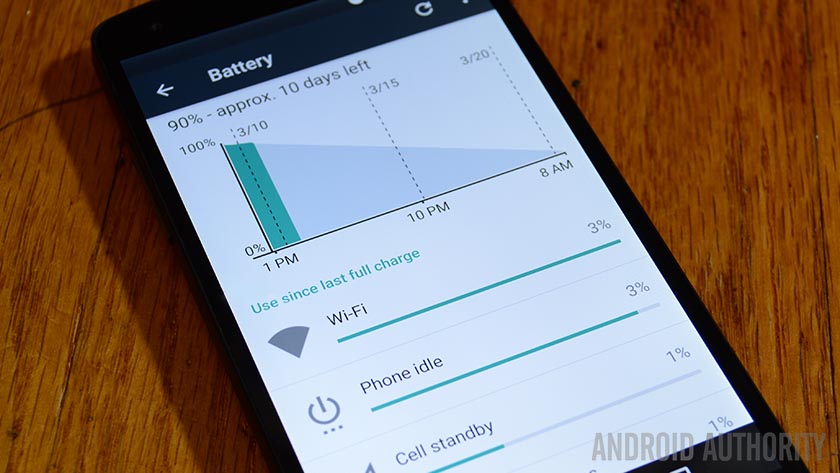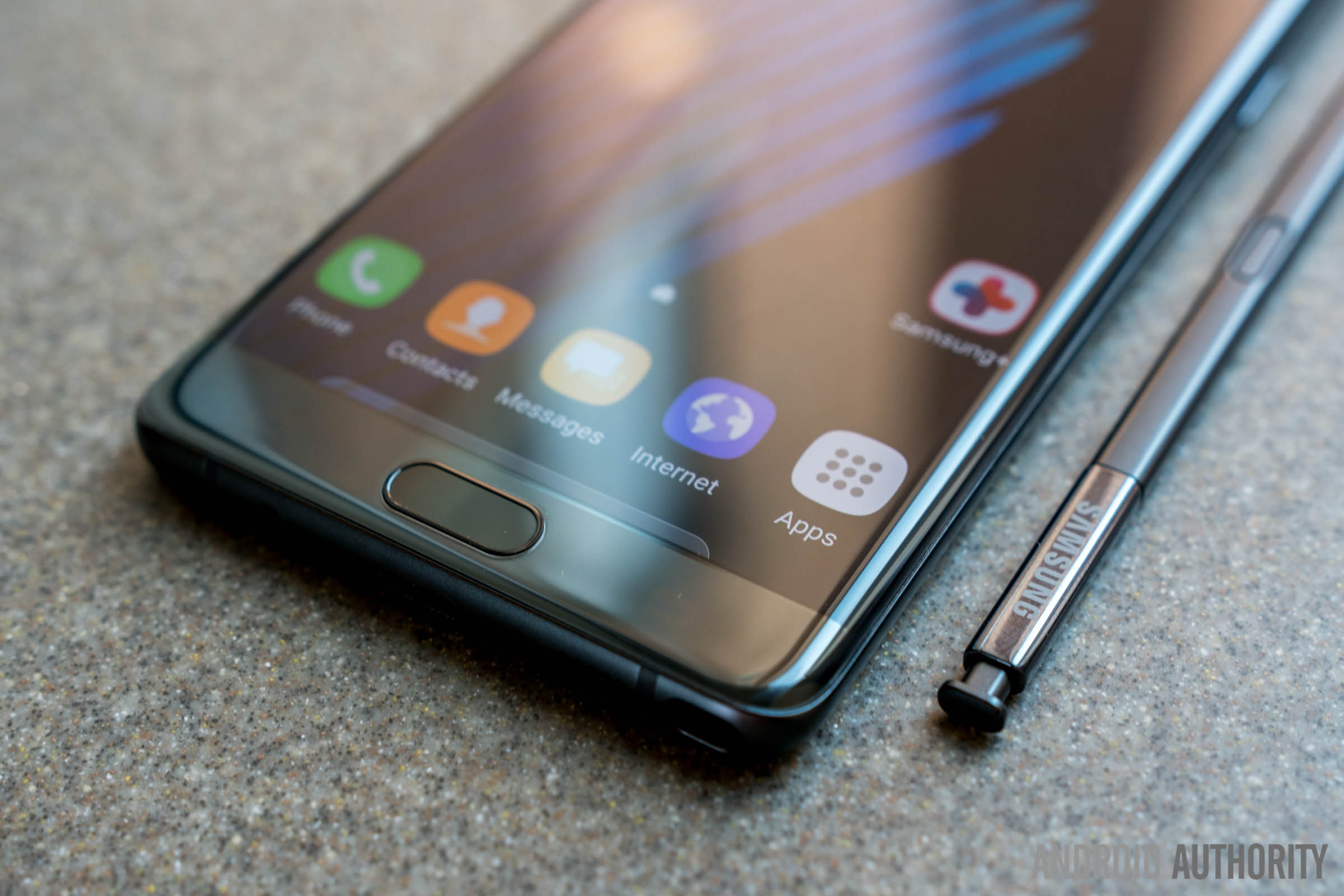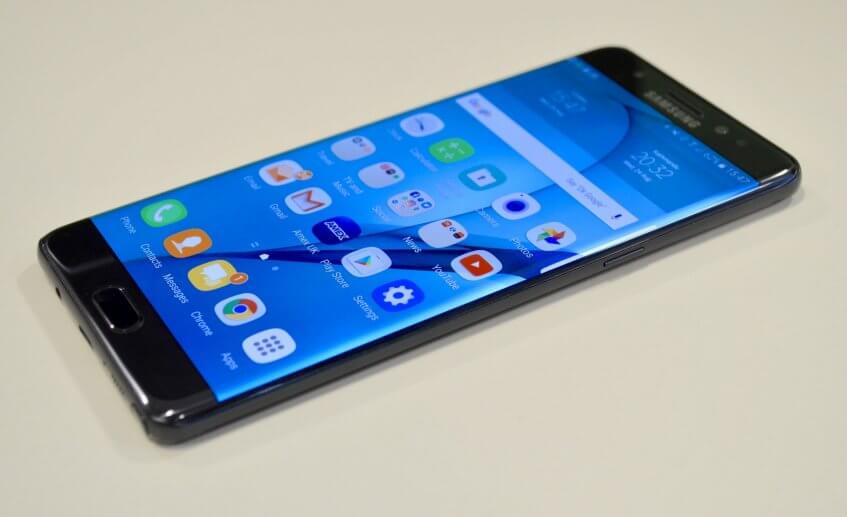
Galaxy S7 is an absolute stunner, a phone packed in a full metal body and it is a rugged IP68 certified device. Like its predecessor it has 5. After releasing Galaxy S6, Samsung is constantly improving design of its S line-up devices and you can nowhere feel it more than in Galaxy S7. Yes, Galaxy S7 proves it. The design of Galaxy S7 is utterly awesome and flawless. This new design concept of Samsung must give Apple something to worry about. Buy or check current price of Galaxy S7. It is the latest flagship of Samsung in Note lineup and also the most defamed device by Samsung due to its battery exploding cases.
Samsung is currently under fire and highly criticized due to this severe issue in this Smartphone. Samsung is currently withdrawing current stock of Galaxy Note 7 from select markets due to this life damaging issue. Before buying this phone, you must confirm with Samsung customer care about the updated stock. Apart from this serious disappointment, Galaxy Note 7 is a great looking smartphone equipped with 5. Depending on market it has a dedicated GB memory slot or a hybrid slot that can also be used to install a Nano SIM card.
Galaxy S7 Edge has most of the tech-specs same as Galaxy Note 7 other than its design and curved display. Unlike Note 7 it has 5. Other than Exynos , it is also available with Snapdragon SoC in select market. Buy or Check current price of Galaxy S7 Edge. Lenovo Zuk Z2 Pro comes with a dedicated heart rate sensor located on its back panel just below the camera. Tests suggest that it is fairly fast and accurate.

However, the availability of this device is limited and we have found it listed on a single Chinese website Oppomart which is shipping it in many countries including United State. Shams, a professional blogger, has expertise in WordPress and Web Hosting. PDA and mobile phone manufacturers competed in reducing the size of devices. The bulk of these smartphones combined with their high cost and expensive data plans, plus other drawbacks such as expansion limitations and decreased battery life compared to separate standalone devices, generally limited their popularity to " early adopters " and business users who needed portable connectivity.
The two components were attached by a hinge in what became known as a clamshell design , with the display above and a physical QWERTY keyboard below. The PDA provided e-mail; calendar, address book, calculator and notebook applications; text-based Web browsing; and could send and receive faxes.
- cellphone tracker tool for Oppo.
- smartphone number location tool Xiaomi Mi 9T.
- Curved front and back!
When closed, the device could be used as a digital cellular telephone. In , Japanese wireless provider NTT DoCoMo launched i-mode , a new mobile internet platform which provided data transmission speeds up to 9. Limited functionality, small screens and limited bandwidth allowed for phones to use the slower data speeds available.
The rise of i-mode helped NTT DoCoMo accumulate an estimated 40 million subscribers by the end of , and ranked first in market capitalization in Japan and second globally. As with other feature phones, additional software and services required partnerships and deals with providers. The degree of integration between phones and carriers, unique phone features, non-standardized platforms, and tailoring to Japanese culture made it difficult for Japanese manufacturers to export their phones, especially when demand was so high in Japan that the companies didn't feel the need to look elsewhere for additional profits.
- Samsung Galaxy Note 7 review: the king of the phablets returns.
- Galaxy A50 cell phone locate.
- Mobile spy for galaxy note 7!
- Samsung DeX 101: Turn a Galaxy phone into your primary computer.
- 7 of the best antivirus software for Android smartphones and tablets?
- Smartphone - Wikipedia;
The rise of 3G technology in other markets and non-Japanese phones with powerful standardized smartphone operating systems , app stores , and advanced wireless network capabilities allowed non-Japanese phone manufacturers to finally break in to the Japanese market, gradually adopting Japanese phone features like emojis , mobile payments, NFC, etc. Phones that made effective use of any significant data connectivity were still rare outside Japan until the introduction of the Danger Hiptop in , which saw moderate success among U.
Later, in the mids, business users in the U. American users popularized the term "CrackBerry" in due to the BlackBerry's addictive nature. Outside the U. Initially, Nokia's Symbian smartphones were focused on business with the Eseries , [41] similar to Windows Mobile and BlackBerry devices at the time. From onwards, Nokia started producing consumer-focused smartphones, popularized by the entertainment-focused Nseries. Until , Symbian was the world's most widely used smartphone operating system.
Mobile spy for galaxy note 7 - Mobile spy free download nero 10 for windows 10
Some even had only a numeric keypad using T9 text input , like the Nokia Nseries and other models in the Nokia Eseries. Resistive touchscreens with stylus -based interfaces could still be found on a few smartphones, like the Palm Treos , which had dropped their handwriting input after a few early models that were available in versions with Graffiti instead of a keyboard. The late s and early s saw a shift in smartphone interfaces away from devices with physical keyboards and keypads to ones with large finger-operated capacitive touchscreens.
In January , Apple Computer introduced the iPhone. The iPhone was notable as being the first device of its kind targeted at the mass market to abandon the use of a stylus, keyboard, or keypad typical of contemporary smartphones, instead using a large touchscreen for direct finger input as its main means of interaction.
The iPhone's operating system was also a shift away from previous ones that were adapted from PDAs and feature phones , to one powerful enough to avoid using a limited, stripped down web browser requiring pages specially formatted using technologies such as WML , cHTML , or XHTML that previous phones supported and instead run a version of Apple's Safari browser that could easily render full websites [51] [52] [53] not specifically designed for phones.
Later Apple shipped a software update that gave the iPhone a built-in on-device App Store allowing direct wireless downloads of third-party software. The advantages of a design with software powerful enough to support advanced applications and a large capacitive touchscreen affected the development of another smartphone OS platform, Android , with a more BlackBerry-like prototype device scrapped in favor of a touchscreen device with a slide-out physical keyboard, as Google's engineers thought at the time that a touchscreen could not completely replace a physical keyboard and buttons.
The iPhone and later touchscreen-only Android devices together popularized the slate form factor , based on a large capacitive touchscreen as the sole means of interaction, and led to the decline of earlier, keyboard- and keypad-focused platforms. As part of a proposed divestment of its consumer business to focus on enterprise software, HP abruptly ended development of future webOS devices in August , and sold the rights to webOS to LG Electronics in , for use as a smart TV platform.
Research in Motion introduced the vertical-sliding BlackBerry Torch and BlackBerry OS 6 in , which featured a redesigned user interface, support for gestures such as pinch-to-zoom, and a new web browser based on the same WebKit rendering engine used by the iPhone. In , Microsoft unveiled a replacement for Windows Mobile known as Windows Phone , featuring a new touchscreen-centric user interface built around flat design and typography, a home screen with "live tiles" containing feeds of updates from apps, as well as integrated Microsoft Office apps.
The announcement led to the abandonment of both Symbian, as well as MeeGo —a Linux-based mobile platform it was co-developing with Intel. Many of these attempts to compete with Android and iPhone were short-lived. Over the course of the decade, the two platforms became a clear duopoly in smartphone sales and market share, with BlackBerry, Windows Phone, and "other" operating systems eventually stagnating to little or no measurable market share.
The following year, the company announced that it would also exit the hardware market to focus more on software and its enterprise middleware, [80] and began to license the BlackBerry brand and its Android distribution to third-party OEMs such as TCL for future devices. Prior to the completion of the sale to Microsoft, Nokia released a series of Android-derived smartphones for emerging markets known as Nokia X , which combined an Android-based platform with elements of Windows Phone and Nokia's feature phone platform Asha , using Microsoft and Nokia services rather than Google.
By the mids, higher-end cell phones commonly had integrated digital cameras. In camera phones outsold stand-alone digital cameras, and in they outsold film and digital stand-alone cameras. Five billion camera phones were sold in five years, and by more than half of the installed base of all mobile phones were camera phones. Sales of separate cameras peaked in Many early smartphones didn't have cameras at all, and earlier models that had them had low performance and insufficient image and video quality that could not compete with budget pocket cameras and fullfill user's needs.
The decline in sales of stand-alone cameras accelerated due to the increasing use of smartphones with rapidly improving camera technology for casual photography, easier image manipulation , and abilities to directly share photos through the use of apps and web-based services.
Cell phone spy software for samsung galaxy note 7
In , digital camera sales were Contributing to the rise in popularity of smartphones being used over dedicated cameras for photography, smaller pocket cameras have difficulty producing bokeh in images, but nowadays, some smartphones have dual-lens cameras that reproduce the bokeh effect easily, and can even rearrange the level of bokeh after shooting. This works by capturing multiple images with different focus settings, then combining the background of the main image with a macro focus shot.
In the Nokia N95 was notable as a smartphone that had a 5. By 5. In the Samsung Omnia HD was the first phone with p video recording.
Free mobile spy for samsung galaxy note 7
A megapixel smartphone with 3x optical zoom was announced in late In Apple introduced the iPhone 7 Plus , one of the phones to popularize a dual camera setup. The Nokia 9 PureView was released in featuring a penta-lens camera system. In the early s, larger smartphones with screen sizes of at least 5. Some companies began to release smartphones in incorporating flexible displays to create curved form factors, such as the Samsung Galaxy Round and LG G Flex.
By , p displays began to appear on high-end smartphones. New trends for smartphone displays began to emerge in , with both LG and Samsung releasing flagship smartphones LG G6 and Galaxy S8 , utilizing displays with taller aspect ratios than the common ratio, and a high screen-to-body ratio, also known as a "bezel-less design". These designs allow the display to have a larger diagonal measurement, but with a slimmer width than displays with an equivalent screen size.
Another trend popularized in were displays containing tab-like cut-outs at the top-centre—colloquially known as a "notch"—to contain the front-facing camera, and sometimes other sensors typically located along the top bezel of a device. This design characteristic appeared almost simultaneously on the Sharp Aquos S2 and the Essential Phone , [] which featured circular tabs for their cameras, followed just a month later by the iPhone X , which used a wider tab to contain a camera and facial scanning system known as Face ID.
Other variations of the practice later emerged, such as a "hole-punch" camera such as those of the Honor View 20, and Samsung's Galaxy A8s and Galaxy S10 —eschewing the tabbed "notch" for a circular or rounded-rectangular cut-out within the screen instead, [] while Oppo released the first "all-screen" phones with no notches at all [] , including one with a mechanical front camera that pops up from the top of the device Find X , [] and a prototype for a front-facing camera that can be embedded and hidden below the display, using a special partially-translucent screen structure that allows light to reach the image sensor below the panel.
Smartphones utilizing flesible displays were theorized as possible once manufacturing costs and production processes were feasible. Also that month, Samsung presented a prototype phone featuring an "Infinity Flex Display" at its developers conference, with a smaller, outer display on its "cover", and a larger, tablet-sized display when opened. Samsung stated that it also had to develop a new polymer material to coat the display as opposed to glass.
The first smartphone with a fingerprint reader was the Motorola Atrix 4G in In , Fairphone launched its first "socially ethical" smartphone at the London Design Festival to address concerns regarding the sourcing of materials in the manufacturing [] followed by Shiftphone in In October , Motorola Mobility announced Project Ara , a concept for a modular smartphone platform that would allow users to customize and upgrade their phones with add-on modules that attached magnetically to a frame.
Microsoft, expanding upon the concept of Motorola's short-lived "Webtop", unveiled functionality for its Windows 10 operating system for phones that allows supported devices to be docked for use with a PC-styled desktop environment. But in , Samsung succumbed to the minimalism trend set by Apple, introducing the Galaxy S6 without a user-replaceable battery.
Major technologies that began to trend in included a focus on virtual reality and augmented reality experiences catered towards smartphones, the newly introduced USB-C connector, and improving LTE technologies. In , the first smartphones featuring fingerprint readers embedded within OLED displays were announced, followed in by an implementation using an ultrasonic sensor on the Samsung Galaxy S In , the majority of smartphones released have more than one camera, are waterproof with IP67 and IP68 ratings, and unlock using facial recognition or fingerprint scanners.
Smartphones have central processing units CPUs , similar to those in computers, but optimised to operate in low power environments. The performance of mobile CPU depends not only on the clock rate generally given in multiples of hertz [] but also on the memory hierarchy.
Because of these challenges, the performance of mobile phone CPUs is often more appropriately given by scores derived from various standardized tests to measure the real effective performance in commonly used applications. One of the main characteristics of smartphones is the screen. Depending on the device's design, the screen fills most or nearly all of the space on a device's front surface. Many smartphone displays have an aspect ratio of , but taller aspect ratios became more common in Screen sizes are measured in diagonal inches.
Phones with screens larger than 5. Smartphones with screens over 4. Due to design advances, some modern smartphones with large screen sizes and "edge-to-edge" designs have compact builds that improve their ergonomics, while the shift to taller aspect ratios have resulted in phones that have larger screen sizes whilst maintaining the ergonomics associated with smaller displays. Some displays are integrated with pressure-sensitive digitizers, such as those developed by Wacom and Samsung , [] and Apple's Force Touch system. Sound quality can remain a problem due to the design of the phone, the quality of the cellular network and compression algorithms used in long-distance calls.
The small speakers can also be used to listen to digital audio files of music or speech or watch videos with an audio component, without holding the phone close to the ear. A smartphone typically uses a lithium-ion battery. Smartphone users purchase additional chargers for use outside the home, at work, and in cars and by buying portable external "battery packs". External battery packs include generic models which are connected to the smartphone with a cable, and custom-made models that "piggyback" onto a smartphone's case.
cell phone spy software for samsung galaxy note 7
In , Samsung had to recall millions of the Galaxy Note 7 smartphones due to an explosive battery issue. Cameras have become standard features of smartphones. As of phone cameras are now a highly competitive area of differentiation between models, with advertising campaigns commonly based on a focus on the quality or capabilities of a device's main cameras. Typically smartphones have at least one main rear-facing camera and a lower-resolution front-facing camera for " selfies " and video chat. Owing to the limited depth available in smartphones for image sensors and optics , rear-facing cameras are often housed in a "bump" that's thicker than the rest of the phone.
Since increasingly thin mobile phones have more abundant horizontal space than the depth that is necessary and used in dedicated cameras for better lenses, there's additionally a trend for phone manufacturers to include multiple cameras, with each optimized for a different purpose telephoto , wide angle , etc.
 Mobile monitoring app for Galaxy Note 7
Mobile monitoring app for Galaxy Note 7
 Mobile monitoring app for Galaxy Note 7
Mobile monitoring app for Galaxy Note 7
 Mobile monitoring app for Galaxy Note 7
Mobile monitoring app for Galaxy Note 7
 Mobile monitoring app for Galaxy Note 7
Mobile monitoring app for Galaxy Note 7
 Mobile monitoring app for Galaxy Note 7
Mobile monitoring app for Galaxy Note 7
 Mobile monitoring app for Galaxy Note 7
Mobile monitoring app for Galaxy Note 7
Related mobile monitoring app for Galaxy Note 7
Copyright 2020 - All Right Reserved